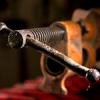Over here in Metricland, screws are reference by their root diameter at the top x length. Pretty simple.
Any of the decent plans or even hardware sold in North America always refer to screw numbers and I've never really comes to terms with it...Until now hopefully.
I was taking a look at the Lee Valley Tap & Drill Sets and noticed that they are for sizes #2-56 up to #10-24. Do these numbers correspond to screw sizes?
I can visualise any of the bolt/tap sizes from #1/4-20 upwards because it's a definitive number based on a calculation but below that is all Greek. I always have to look up the size of say the #8-32 in decimal and then convert to Metric and then exclaim "Ah it's close to 4mm!".
I've probably even more confused now because I have no idea what a #5 or #14 screw looks like or even which tap/drill set to get to substitute the wood screw for a machine screw.
Do I just suck it up, print out a nice chart and worry about World Peace instead?
fanx.





 Reply With Quote
Reply With Quote
 I can't tell you why thread standards resort to this crazy numbering scheme below 1/4", but it does.
I can't tell you why thread standards resort to this crazy numbering scheme below 1/4", but it does.






